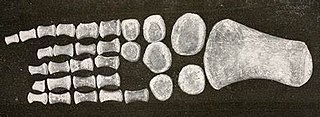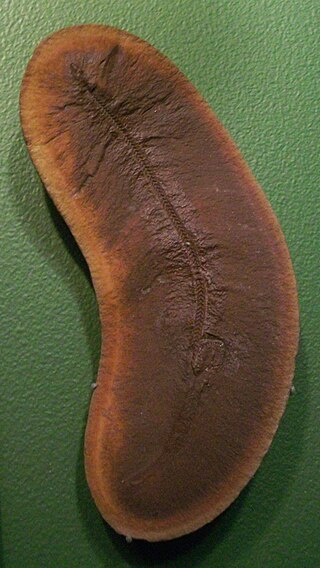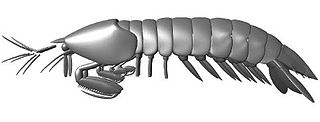
Tullimonstrum, colloquially known as the Tully monster or sometimes Tully's monster, is an extinct genus of soft-bodied bilaterian animal that lived in shallow tropical coastal waters of muddy estuaries during the Pennsylvanian geological period, about 300 million years ago. A single species, T. gregarium, is known. Examples of Tullimonstrum have been found only in the Essex biota, a smaller section of the Mazon Creek fossil beds of Illinois, United States. Its classification has been the subject of controversy, and interpretations of the fossil have likened it to molluscs, arthropods, conodonts, worms, tunicates, and vertebrates. This creature had a mostly cigar shaped body, with a triangular tail fin, two long stalked eyes, and a proboscis tipped with a mouth-like appendage. Based on the fossils, it seems this creature was a nektonic carnivore that hunted in the ocean’s water column. When Tullimonstrum was alive, Illinois was a mixture of ecosystems like muddy estuaries, marine environments, and rivers and lakes. Fossils of other organisms like crustacean Belotelson, the cnidarian Essexella, and the elasmobranch fish Bandringa have been found alongside Tullimonstrum.
Lysorophia is an order of fossorial Carboniferous and Permian tetrapods within the Recumbirostra. Lysorophians resembled small snakes, as their bodies are extremely elongate. There is a single family, the Molgophidae. Currently there are around five genera included within Lysorophia, although many may not be valid.
The Mazon Creek fossil beds are a conservation lagerstätte found near Morris, in Grundy County, Illinois. The fossils are preserved in ironstone concretions, formed approximately 309 million years ago in the mid-Pennsylvanian epoch of the Carboniferous period. These concretions frequently preserve both hard and soft tissues of animal and plant materials, as well as many soft-bodied organisms that do not normally fossilize. The quality, quantity and diversity of fossils in the area, known since the mid-nineteenth century, make the Mazon Creek lagerstätte important to paleontologists attempting to reconstruct the paleoecology of the sites. The locality was declared a National Historic Landmark in 1997.

Protorothyrididae is an extinct family of small, lizard-like reptiles belonging to Eureptilia. Their skulls did not have fenestrae, like the more derived diapsids. Protorothyridids lived from the Late Carboniferous to Early Permian periods, in what is now North America. Many genera of primitive reptiles were thought to be protorothyridids. Brouffia, Coelostegus, Paleothyris and Hylonomus, for example, were found to be more basal eureptiles in Muller and Reisz (2006), making the family as historically defined paraphyletic, though three genera, Protorothyris, Anthracodromeus, and Cephalerpeton, were recovered as a monophyletic group. Anthracodromeus, Paleothyris, and Protorothyris were recovered as a monophyletic group in Ford and Benson (2020), who recovered them as more derived than captorhinids and Hylonomus, but less so than araeoscelidians. Anthracodromeus is the earliest known reptile to display adaptations to climbing. The majority of phylogenetic studies recover protorothyridids as basal members of Eureptilia; however, Simões et al. (2022) recover them as stem-amniotes instead.
Pohlsepia mazonensis is a species of fossil organism with unknown affinity. Although it was originally identified as an extinct cephalopod, later studies denied that interpretation. The species is known from a single exceptionally preserved fossil discovered in the late Carboniferous (Pennsylvanian) Francis Creek Shale of the Carbondale Formation, north-east Illinois, United States.

Helenodora is an extinct basal onychophoran or lobopodian genus known from the Carboniferous Carbondale Formation of Illinois. The only known species described is H. inopinata. The ecology of this animal is not well known, but it is thought that it may have lived on land and/or underwater.

Ogmodirus is an extinct genus of plesiosaur found in the Cenomanian-Turonian Greenhorn Limestone of Kansas. The type species, O. martini, was named by Samuel Wendell Williston and Roy Lee Moodie in 1913.

Pseudophlegethontia is an extinct genus of aïstopod tetrapodomorphs. It is the only member of the family Pseudophlegethontiidae. The only species is the type species P. turnbullorum, named in 2003. Fossils of Pseudophlegethontia have been found from the Mazon Creek fossil beds in Grundy County, Illinois, a conservation lagerstätte well known for the exceptional preservation of middle Pennsylvanian taxa.

Anaschisma is an extinct genus of large temnospondyls. These animals were part of the family called Metoposauridae, which filled the crocodile-like predatory niches in the late Triassic. It had large skull about 62 centimetres (24 in) long, and possibly reached 3 metres (9.8 ft) long. It was an ambush hunter, snapping up anything small enough to fit in its huge jaws. It was very common during the Late Triassic in what is now the American Southwest.
Illiniichthys is an extinct genus of prehistoric bony fish that lived during the late Moscovian stage of the Pennsylvanian epoch in what is now Illinois, United States. Fossils were collected from the Mazon Creek fossil beds. The genus is named after the Illini Native American tribe.
Nozamichthys is an extinct genus of prehistoric bony fish that lived during the late Moscovian stage of the Pennsylvanian epoch in what is now Illinois, United States. Fossils were collected from the Mazon Creek fossil beds. The first part of the genus name is Mazon spelled backwards, and the second part means 'fish'.

Brachystelechidae is an extinct family of Early Permian microsaurs. The family was first named by Robert L. Carroll and Pamela Gaskill in 1978, with the only member being Brachystelechus fritschi. Brachystelechus fritschi has since been reassigned to the genus Batropetes. Genera assigned to the family include: Batropetes, from Germany; Carrolla, from Texas; Quasicaecilia, also from Texas; Diabloroter, from the Mazon Creek lagerstätte of Illinois; and Bromerpeton from the Tambach Formation of Germany.

Belotelson is a genus of crustaceans, in the extinct order Belotelsonidea, containing at least two species. It was first named by Packard in 1886 from material found in the Mazon Creek lagerstätte in Illinois. Its fossils have been found in Pennsylvanian age rocks.

The Amphibamidae are an ancient family of dissorophoid temnospondyls known from Late Carboniferous-Early Permian strata in the United States.

Cephalerpeton is an extinct genus of "protorothyridid" eureptile known from the Late Carboniferous of Illinois.

Paleontology in Illinois refers to paleontological research occurring within or conducted by people from the U.S. state of Illinois. Scientists have found that Illinois was covered by a sea during the Paleozoic Era. Over time this sea was inhabited by animals including brachiopods, clams, corals, crinoids, sea snails, sponges, and trilobites.

Essexella is an extinct genus of cnidarian known from Late Carboniferous fossils; it contains a single species, E. asherae. It is one of the most recurrent organisms in the Mazon Creek fossil beds of Illinois; in the Essex biota of Mazon Creek, it consists of 42% of all fossil finds. Essexella was originally described as a jellyfish, but was recently redescribed as a sea anemone. The scientists on the "anemone" side of the debate made a book as early as 2017, but it was ignored until the same authors made a proper scientific paper in 2023.

Bandringa is an extinct genus of elasmobranch known from the Pennsylvanian subperiod of the Carboniferous period that was part of the monotypic family Bandringidae. There is currently a single known species, B. rayi, described in 1969. It is known from exceptionally preserved individuals found in the Mazon Creek Lagerstätte of Illinois which dates back to the late Moscovian stage.
Carbotubulus is a genus of extinct worm belonging to the group Lobopodia and known from the Carboniferous Carbondale Formation of the Mazon Creek area in Illinois, US. A monotypic genus, it contains one species Carbotubulus waloszeki. It was discovered and described by Joachim T. Haug, Georg Mayer, Carolin Haug, and Derek E.G. Briggs in 2012. With an age of about 300 million years, it is the first long-legged lobopodian discovered after the period of Cambrian explosion.

Tyrannophontes is an extinct genus of mantis shrimp that lived during the late Carboniferous period in what is now the Mazon Creek fossil beds of Illinois. It is the only genus in the family Tyrannophontidae. The type species, T. theridion, was described in 1969 by Frederick Schram. A second, much larger species, T. gigantion, was also named by Schram in 2007. Two other species were formerly assigned to the genus, but have since been reclassified.




















